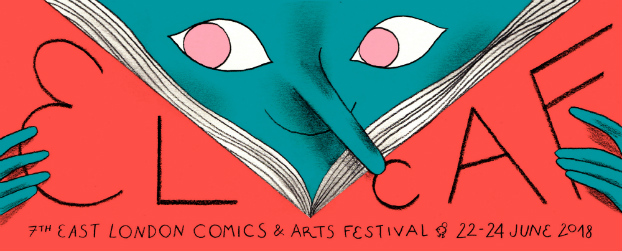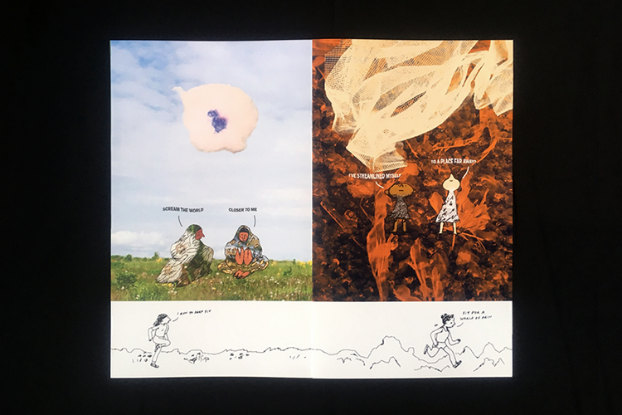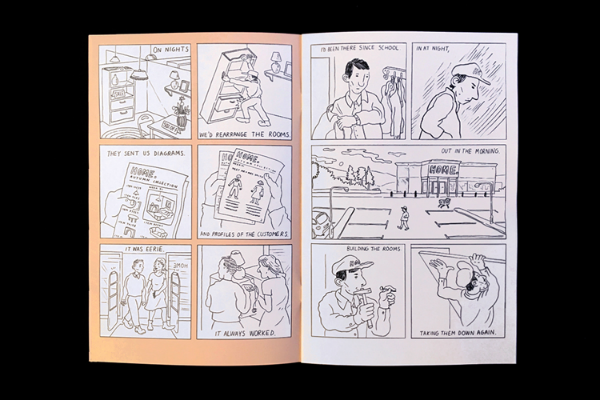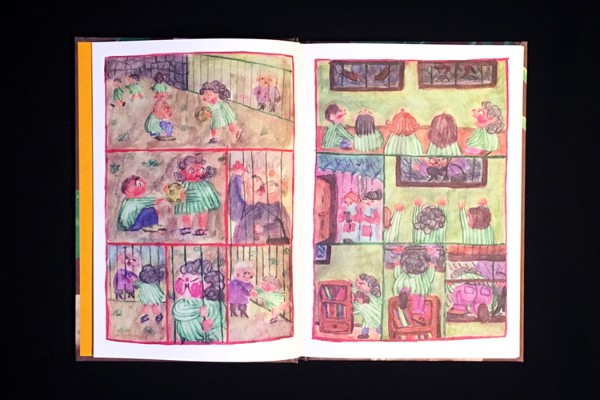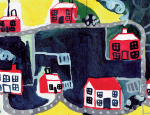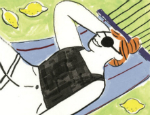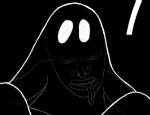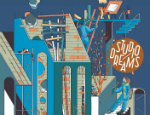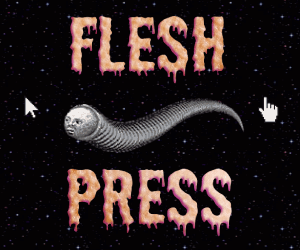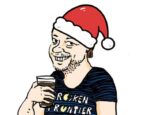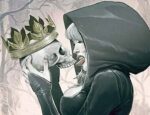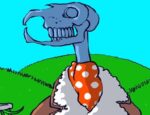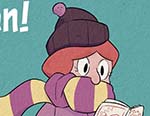ELCAF FORTNIGHT!
João Sobral established O Panda Gordo in 2011 in his native Portugal, before upping sticks and moving over to Glasgow in 2014. It’s here that the nascent publisher/distributor combo really took root, with Sobral occupying a hitherto vacant niche in the UK small press scene: with his own bilingual cartooning talents and an international network of talented pals, O Panda Gordo prints and disseminates work by talented and diverse artists from the world over, often with a humanist bent and handmade aesthetic.
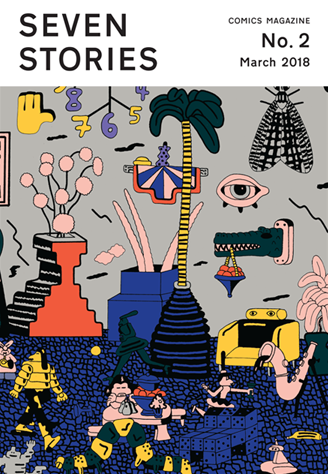 In the past few years the micropublisher has put out work by Sweden’s Disa Wallander, Portugese illustators André da Loba and Mariana Pita, and Scotland’s own Chris Kohler, in both individual volumes and Sobral’s anthology series Seven Stories. I caught up with João over email to talk his cartooning origin story, the challenges of running a small press publisher/distro, and what he’ll be bringing to this year’s ELCAF.
In the past few years the micropublisher has put out work by Sweden’s Disa Wallander, Portugese illustators André da Loba and Mariana Pita, and Scotland’s own Chris Kohler, in both individual volumes and Sobral’s anthology series Seven Stories. I caught up with João over email to talk his cartooning origin story, the challenges of running a small press publisher/distro, and what he’ll be bringing to this year’s ELCAF.
BROKEN FRONTIER: To start off broadly, how would you describe the sort of comics you publish?
JOÃO SOBRAL: It’s difficult for me to answer that. I think about it from time to time – I look at what I have published and try to figure out what I should publish next. But I never really take anything out of those reflections. Well, first of all I publish my own comics, whatever I want to put out from myself. And then I guess it just expands naturally depending on personal relations that I already had or that I start because of comics: going to fairs, contacting other artists online, etc. Comics is still a relatively new world to me, I started making comics before I was a proper reader of comics. I didn’t read comics as a kid or a teenager. I became fascinated with the medium some years ago and started experimenting with it at the same time that I was getting to know the worlds of alternative/indie/underground comics.
I think I still feel that strong fascination when I find new work that really connects with me, and sometimes that connection is strong enough to make me want to publish or distribute that work. But I don’t think I can describe all that work under the same terms. I think the cartoonists I’ve published in the past year, Disa Wallander, Chris Kohler, Gore Krout, Mariana Pita, they all make very different comics and the things I appreciate in each of them are not exactly the same but they are all very special to me.
Spare Me by Disa Wallander
In Seven Stories, you can see even more examples of very distinct practices, and although the second issue has a more visible aesthetic cohesion, I wouldn’t describe all those comics in the same way, I think they result from very different approaches to the medium. And that’s precisely another thing I love about comics, the multitude of possibilities of approaches and processes and results, even if that’s not what is normally associated with comics for a lot of people.
BF: It’s interesting that you came to comics without much experience in reading them! Were there any particular artists/comics that brought you around, and did you have any sort of artistic background beforehand?
SOBRAL: I talk about it on the editorial I wrote for Seven Stories #2, actually. I was studying Communication Design (in Porto, Portugal, where I’m from) and as part of the degree I had a lot of different mandatory classes including Life Drawing where I had to make realistic drawings and I absolutely hated it! But after that, I had Illustration classes where I was encouraged to explore new ways of drawing without feeling the pressure to do it “right”. So I slowly started enjoying drawing. Around the same time (this was 2013) I discovered the work of some artists/illustrators who were using drawing in a way I found fascinating and exciting – Faye Coral Johnson, Mike Redmond, Geran Knol, Bloeme van Bon, Inka Leontine, Nous Vous, Giada Ganassin, Martha Verschaffel, and more.
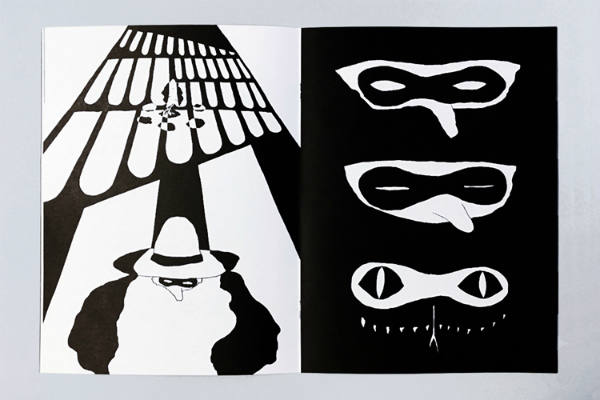
No Mouth’s The Hum by Gore Krout
Even though they were not making actual comics, a lot of their artworks were structured in panels or consisted of several drawings or had cartoony characters. That’s what made me interested in sequential drawing, which I later realised was just called comics. I already knew a few people doing indie comics – Marcos Farrajota from Chili Com Carne, and Rudolfo – that I’d met a lot of times in zine fairs in Portugal, but I was not really interested in what they were doing at that time. So that’s how it all started and I’ve been discovering and falling in love with a lot of different comics since then, to the point that it’s become an obsession.
BF: That seems like an opportunity to talk about the other element of O Panda Gordo! Along with publishing books by yourself and others, you also sell books from other publishers and artists. Can you tell me a little about how the distribution side of things started, and how the day-to-day of it compares to publishing?
SOBRAL: The distro part started when I moved out of Portugal in 2014 and brought a lot of stuff from friends to sell in London, where I lived for one year and where I attended a lot of small zine fairs and art markets. After relocating to Glasgow, the distro was asleep for a while. I only had what was left from the fairs in London, but I wasn’t going to fairs anymore because Glasgow is not as busy with that kind of events as London. When I launched the new O Panda Gordo website I put some of that stuff online and after that I started getting new stock, this time not only from Portuguese friends, but from other people I knew or admired and wanted to promote and support.
Living Room by Chris Kohler
Today I try to have a selection of stuff I love and wouldn’t mind to have published myself, mostly focussing on getting stuff that is not available in Glasgow or the UK, and also trying to promote some Scotland-based cartoonists. The selection is very limited to budget restrictions though. It always depends on how much money I have available for O Panda Gordo and is not already aside for my own releases, which is never a lot because things sell very, very slowly…
BF: Speaking of zine fairs and conventions, would you like to take this opportunity to introduce readers to some of the things you’ll have on sale at ELCAF this year?
SOBRAL: Yes, that sounds like a good idea! I don’t have anything coming out just for ELCAF but I have published several new titles since I was there last year so there’s a lot of new stuff for the London audience, hehe. I’d start with Seven Stories #2 featuring cover artwork by Elliot Snowman, and comics by Bruno Borges, Lasse Wandschneider, Nick Norman, Émilie Gleason, Giada Ganassin, Marie Weber, and Mike S Redmond and Faye Coral Johnson. Seven Stories #1 debuted at ELCAF last year and I’m very happy to come back with the second issue!
I also want to highlight Outside with the Cuties (above), a book I co-published with Portuguese publisher Chili Com Carne. It’s an anthology of original and previously published short comics by Mariana Pita. Her work is great and deserves everyone’s attention! I really think that this book might be lovely surprise to a lot of people so I recommend everyone to check it out! Apart from that, I have three zines I love equally even if they are very different from each other: Spare Me by super talented Disa Wallander, Living Room by Glasgow-based Chris Kohler, and No Mouth’s The Hum by the mysterious Gore Krout.
On the distro part of the table, some of the hot things that can be found are Propaganda, a great book by Joana Estrela, a few different zines by Laura Endy, A Temporary Situation by Julia Scheele, Polly Who? by Jem Milton, Book of Daze by E. A. Bethea, and But is it… Comic Aht?, the new exciting comics magazine edited by Austin English and published by Domino Books! And these are just a few examples!
O Panda Gordo will be exhibiting at ELCAF. You can buy O Panda Gordo comics here and follow them on Twitter here.
Catch up on all our ELCAF Fortnight articles to date here. ELCAF runs from June 22nd-24th. Full details on the ELCAF site here and you can also follow the festival on Twitter here.
